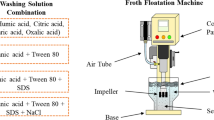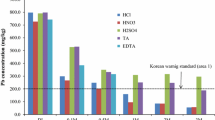Abstract
The optimal soil-washing conditions for dioxins were estimated on a soil sample from the circumference of an incinerator in Nose City, Osaka, Japan. The solvents ethanol, methanol, and acetone, together with a surfactant (100% of each) could extract 40% of the dioxins from contaminated soil at room temperature. From among these solvents, ethanol was chosen for a study on how to optimize the extraction conditions because of its low toxicity and its economic advantages. The time-course of the agitation showed that the extraction rate increased for 1 min, and thereafter the rate decreased. Therefore, the agitation time was fixed at 1 min. To estimate the effect of temperature on the extraction rate, the extraction temperature was changed. The amount of dioxins extracted was largest at the boiling point of ethanol (78.3°C), giving about 76% extraction. Furthermore, at this temperature, almost 100% of the dioxins in the contaminated soil were extracted when the ratio of water to ethanol was 20%.
Similar content being viewed by others
Author information
Authors and Affiliations
Additional information
Received: March 6, 2002 / Accepted: September 9, 2002
Rights and permissions
About this article
Cite this article
Nakamiya, K., Furuichi, T. & Ishii, K. Evaluation of the optimal washing conditions for dioxin-contaminated soils from the circumference of an incinerator. J Mater Cycles Waste Manag 5, 0063–0068 (2003). https://doi.org/10.1007/s101630300010
Issue Date:
DOI: https://doi.org/10.1007/s101630300010




